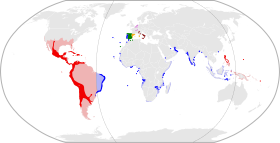
Back Corona Hispanica AN Monarquia d'Espanya Catalan Monarquía Hispánica Spanish Monarkia Hispaniko Basque Monarchie catholique espagnole French Monarchia Hispanica Latin Monarquia Católica Portuguese
Monarchy of Spain Monarquia de España (Spanish) | |
|---|---|
| 1479–1716 | |
 | |
| Capital | Madrid (1561-1601)
Valladolid (1601-1606) Madrid (since 1606) |
| Official languages | Spanish |
| Religion | Catholicism |
| Government | Composite monarchy |
| History | |
• Established | 1479 |
• Disestablished | 1716 |
| Currency | Spanish real |
The Hispanic Monarchy (Monarquia Hispanica in spanish), also known as Catholic Monarchy[1] and historically referred to as Monarchy of Spain[a], was the political entity encompassing the territories and dependencies of the Spanish Empire between 1479 and 1716. These regions maintained distinct, individual public institutions, councils, and legal systems, but were united under the control of a superior entity (the King of Spain)[2] and common state institutional structures. This monarchy was administered under a polysynodial system of councils. The Spanish monarch acted as king (or with the corresponding title) according to the political constitution of each kingdom, state, or lordship,[3] and thus, their formal power varied from one territory to another. However, they acted as a unified monarch over all the territories of the monarchy,[4] almost like a Composite Monarchy.
The Monarchy included the Crown of Castile — with Granada, Navarre and the kingdoms of the Indies — and Aragon — with Sicily, Naples, Sardinia, and the State of the Presidi —, Portugal and its overseas territories between 1580 and 1640, the territories of the Burgundian Circle except between 1598-1621 — Franche-Comté, the Netherlands, as well as Charolais —, the Duchy of Milan, the Marquisate of Finale, the Spanish East Indies, and Spanish Africa.[5][6]
The monarchy ended with the Treaties of Utrecht and Baden (1713-1714) and the Nueva Planta Decrees (1707-1716),[7] which produced a break in the system by implementing greater homogeneity and political centralization, relegating the polysynodial system.[8][9]
- ^ Álvarez, Manuel Fernández (1979-01-01). España y los españoles en los tiempos modernos (in Spanish). Universidad de Salamanca. ISBN 978-84-7481-082-0.
- ^ Rodríguez, José Ignacio Ruiz (2005). Apuntes de historia del derecho y de las instituciones españolas (in Spanish). Editorial Dykinson, S.L. ISBN 978-84-9772-666-5.
- ^ Mendoza, Pedro Salazar de (1770). Monarquía de España (in Spanish). por D. Joachin Ibarra, impresor de Cámara de S. M.
- ^ Martín, Felipe Ruiz (2003). La monarquía de Felipe II (in Spanish). Real Academia de la Historia. ISBN 978-84-95983-30-5.
- ^ Boletin de la Real Academia de la Historia. TOMO CLXXIII. NUMERO II. AÑO 1976 (in Spanish). Real Academia de la Historia.
- ^ Alcalá-Zamora, José N. (2005). Felipe IV: el hombre y el reinado (in Spanish). CEEH. ISBN 978-84-934643-0-1.
- ^ Alcalá-Zamora, José N. (2005). Felipe IV: el hombre y el reinado (in Spanish). CEEH. ISBN 978-84-934643-0-1.
- ^ Abreu, Consuelo Maqueda (1992-01-01). El auto de fe (in Spanish). Ediciones AKAL. ISBN 978-84-7090-272-7.
- ^ Ruiz, Enrique Martínez; Guiménez, Enrique (1994). Introducción a la historia moderna (in Spanish). Ediciones AKAL. ISBN 978-84-7090-293-2.
Cite error: There are <ref group=lower-alpha> tags or {{efn}} templates on this page, but the references will not show without a {{reflist|group=lower-alpha}} template or {{notelist}} template (see the help page).
© MMXXIII Rich X Search. We shall prevail. All rights reserved. Rich X Search

